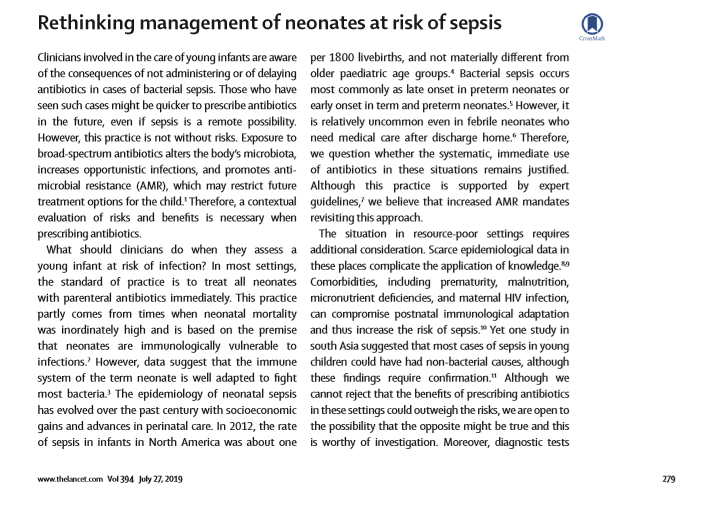Clinicians involved in the care of young infants are aware of the consequences of not administering or of delaying antibiotics in cases of bacterial sepsis. Those who have seen such cases might be quicker to prescribe antibiotics in the future, even if sepsis is a remote possibility. However, this practice is not without risks. Exposure to broad-spectrum antibiotics alters the body’s microbiota, increases opportunistic infections, and promotes antimicrobial resistance (AMR), which may restrict future treatment options for the child.1 Therefore, a contextual evaluation of risks and benefits is necessary when prescribing antibiotics.
What should clinicians do when they assess a young infant at risk of infection? In most settings, the standard of practice is to treat all neonates with parenteral antibiotics immediately. This practice partly comes from times when neonatal mortality was inordinately high and is based on the premise that neonates are immunologically vulnerable to infections.2 However, data suggest that the immune system of the term neonate is well adapted to fight most bacteria.3 The epidemiology of neonatal sepsis has evolved over the past century with socioeconomic gains and advances in perinatal care. In 2012, the rate of sepsis in infants in North America was about one per 1800 livebirths, and not materially different from older paediatric age groups.4 Bacterial sepsis occurs most commonly as late onset in preterm neonates or early onset in term and preterm neonates.5 However, it is relatively uncommon even in febrile neonates who need medical care after discharge home.6 Therefore, we question whether the systematic, immediate use of antibiotics in these situations remains justified. Although this practice is supported by expert guidelines,7 we believe that increased AMR mandates revisiting this approach.
The situation in resource-poor settings requires additional consideration. Scarce epidemiological data in these places complicate the application of knowledge.8, 9 Comorbidities, including prematurity, malnutrition, micronutrient deficiencies, and maternal HIV infection, can compromise postnatal immunological adaptation and thus increase the risk of sepsis.10 Yet one study in south Asia suggested that most cases of sepsis in young children could have had non-bacterial causes, although these findings require confirmation.11 Although we cannot reject that the benefits of prescribing antibiotics in these settings could outweigh the risks, we are open to the possibility that the opposite might be true and this is worthy of investigation. Moreover, diagnostic tests are often unavailable in these settings, thus antibiotics can be started without measures to inform cessation of therapy. Non-resilient health systems typically don’t have the safety net for advanced care of the critically ill patients, which creates an over-reliance on antibiotics.
We call for a more judicious use of antibiotics in neonates, discouraging their systematic empiric use when sepsis is only a remote possibility. In line with the 2018 North American recommendations,12 models of care should be adapted to facilitate serial clinical and laboratory assessments rather than immediate treatment in low-risk infants. Clinical decision algorithms should evaluate the effectiveness and safety of withholding antibiotics in specific subgroups,13 which could include those who appear to be well at the time of assessment or who only have a low-grade fever.14Efforts should focus on educating health workers in recognising early danger signs.15 Research is needed to develop pragmatic, severity-based definitions for neonatal sepsis. In low-resource settings, there is an urgent need for a universal application of measures that have proven effective in reducing infant mortality over the past century in resource-rich countries,16including improving sanitary conditions at birth, access to health care and safe milk, and vaccination. Robust actions are needed to bolster resilience of health systems to prevent, diagnose, and treat the ill neonate, including local access to neonatal expertise. Finally, access to existing laboratory tests for diagnosing sepsis (eg, procalcitonin, C-reactive protein) need to be facilitated, and next-generation diagnostic tests that are fast, reliable, and widely accessible need to be developed to address the limitations of the current reference standard blood culture that is insensitive and prone to contamination, especially in resource-poor settings.
Research will be needed to counteract entrenched and traditional thinking and support practice changes. Widespread antibiotic use in neonates without addressing the fundamental sanitary and operational health system issues fuels AMR and will eventually render use of antibiotics obsolete for those who truly need these drugs.17 Changes need to be deliberate and include consideration of pathophysiology and the local context. These daunting tasks must be addressed to ensure that improvements in neonatal health are sustainable across nations.
